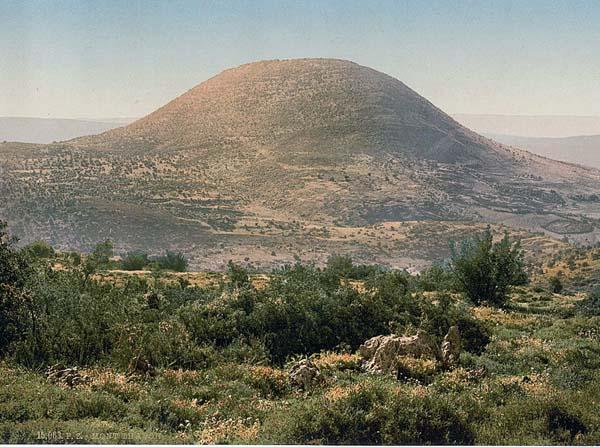
MOUNT TABOR.
THE following description of Tabor, from the pen of a traveler, Rev. S. D. Phelps, will be interesting, whether or not we accept it as the mount of transfiguration:
''This charming little mountain has an isolated position on the plain of Esdraelon, about twelve miles west of the Sea of Galilee. It is nearly two thousand feet above the sea-level, and unlike other mountains of Palestine, is wooded nearly to the top.
It is several times mentioned in the Old Testament, but not once by name in the New. But our blessed Lord must have been familiar with it from childhood, as it is but six miles east of Nazareth, and in full view from the western bank of the Sea of Galilee. From the fourth century until modern times, it was regarded as the scene of our Lord's transfiguration. No place could be more befitting; and notwithstanding the objection urged on account of the fortress on the summit, we thought as we wandered around the brow of that summit, and saw how many retired and shady nooks were there how many secluded spots of charming loveliness admirably adapted to such a celestial scene it surely-might have occurred here on this 'high mountain apart.' It was here or on a spur of Hermon yonder.
"Tabor is associated with the warlike exploits of Deborah and Barak in the times of the Judges. As she gave the signal on its summit, Barak with the troops rushed down the southern slope and met the mighty foe in the valley of Meggiddo where 'the stars in their courses fought against Sisera,' and where 'the river Kishon swept them away that ancient river the river Kishon.'
''It was a beautiful spring afternoon when we climbed up the winding and sometimes very rocky path to the summit of Tabor.
A nearly level space half a mile long and half as broad at the top, is surrounded by old walls and ruined structures, one of which is a Saracenic arch called the Tower of the Winds. These ruins are partly covered with tangled thickets of thorn, dwarf oak, and rank thistles. Several deep cisterns or pits hewn in the rock are there.
In the center of the area is an open space of garden-like beauty a grassy lawn beaming with gay and lovely flowers. Amid the ruins is a habitation for one or two monks or hermits.
"The views from Tabor are varied and enchanting. We remember well how eagerly we looked from the highest point toward the northeast, and with inexpressible emotions caught a first glimpse of the Sea of Galilee where its waters lave the shores near the sites of Capernaum and Bethsaida. The course of the Jordan for a long distance can be traced, and beyond it a boundless perspective of hills and valleys stretches over ancient Gilead and Bashan. Looking south, the broad and beautiful plain of Esdraelon spreads away to the hills of Samaria, an unbroken expanse of verdure, a velvet lawn of loveliness, soft, tranquil, dream-like and unencumbered, yet in ages past the battle-ground of nations. On its eastern border hang Little Hermon and the villages of Endor and Nain, and south of these rises Gilboa, whose 'high places' witnessed the death of Saul and Jonathan. Further on are the mountains of Ephraim. Westward, the eye sweeps across the plain to 'the excellency of Carmel' and follows its bold ridge till its farthest northern slope dips into the Mediterranean Sea, which lies like a dark line in the purple horizon. The hills of Galilee intervene and enclose the memorable and pleasant village of Nazareth. Rich fields of blooming shrubbery break off at the north, from which rise the Horns of Hattin, known as the Mount of Beatitudes. Beyond are the ranges of Lebanon, one of the nearer heights crowned with Safed, 'a city set upon a hill,' and in the dim distance towers the cone of Mount Hermon, snowcapped and majestic, like a dome of glory. Thus 'Tabor is among the mountains and Carmel by the sea.' 'The north and the south, thou hast created them; Tabor and Hermon shall rejoice in thy name.'"